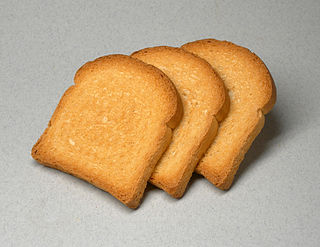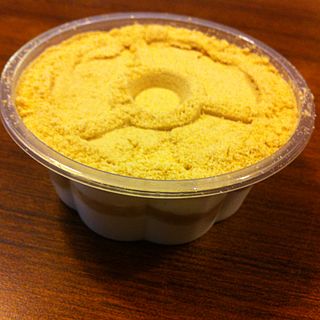
Cream is a dairy product composed of the higher-fat layer skimmed from the top of milk before homogenization. In un-homogenized milk, the fat, which is less dense, eventually rises to the top. In the industrial production of cream, this process is accelerated by using centrifuges called "separators". In many countries, it is sold in several grades depending on the total butterfat content. It can be dried to a powder for shipment to distant markets, and contains high levels of saturated fat.

Dessert is a course that concludes a meal. The course consists of sweet foods, such as cake, and possibly a beverage such as dessert wine and liqueur. Some cultures sweeten foods that are more commonly savory to create desserts. In some parts of the world there is no tradition of a dessert course to conclude a meal.

Gravy is a topping or sauce often made from the juices of meats that run naturally during cooking and often thickened with corn starch for added texture. The gravy may be further coloured and flavoured with gravy salt or gravy browning or ready-made cubes. Powders can be used as a substitute for natural meat or vegetable extracts. Canned and instant gravies are also available. Gravy is commonly served with roasts, meatloaf, rice, noodles, chips (fries), mashed potatoes, or biscuits.

A pancake is a flat cake, often thin and round, prepared from a starch-based batter that may contain eggs, milk and butter and cooked on a hot surface such as a griddle or frying pan, often frying with oil or butter. It is a type of batter bread. Archaeological evidence suggests that pancakes were probably eaten in prehistoric societies.

Pralines are confections containing nuts – usually almonds, pecans and hazelnuts – and sugar. Cream is a common third ingredient.

A crêpe or crepe is a very thin type of pancake. Crêpes are usually one of two varieties: sweet crêpes or savoury galettes. They are often served with a wide variety of fillings such as cheese, fruit, vegetables, meats, and a variety of spreads. Crêpes can also be flambéed, such as in crêpes Suzette.

Condensed milk is cow's milk from which water has been removed. It is most often found with sugar added, in the form of sweetened condensed milk (SCM), to the extent that the terms "condensed milk" and "sweetened condensed milk" are often used interchangeably today. Sweetened condensed milk is a very thick, sweet product, which when canned can last for years without refrigeration if not opened. The product is used in numerous dessert dishes in many countries.

A rusk is a hard, dry biscuit or a twice-baked bread. It is sometimes used as a teether for babies. In some cultures, rusk is made of cake, rather than bread: this is sometimes referred to as cake rusk. In the UK, the name also refers to a wheat-based food additive.

Bambi a.d. is a food manufacturing company headquartered in the town of Požarevac, Serbia. One of its signature products is a biscuit called Plazma, also known as Lane outside of former Yugoslavia. It is currently owned by Coca-Cola HBC Serbia.

A polvorón is a type of heavy, soft, and very crumbly Spanish shortbread made of flour, sugar, milk, and nuts. They are mostly produced in Andalusia, where there are about 70 factories that are part of a syndicate that produces polvorones and mantecados. Under the name mantecados, these sweets are a traditional preparation of other areas of the Iberian Peninsula and other Spanish-speaking countries as well.
Plasmon biscuits are a biscuit containing plasmon, a proprietary dried milk. The manufacturers claimed that three pounds (1.4 kg) of plasmon equalled 100 imperial pints (57 L) of milk. Plasmon was manufactured by the International Plasmon Company and was added to a number of different products to make Plasmon Oats, Plasmon Cocoa and Plasmon Biscuits. Plasmon biscuits are still manufactured in Italy by the H. J. Heinz Company.

Sponge cake is a light cake made with egg whites, flour and sugar, sometimes leavened with baking powder. Some sponge cakes do not contain egg yolks, like angel food cake, but most of them do. Sponge cakes, leavened with beaten eggs, originated during the Renaissance, possibly in Spain. The sponge cake is thought to be one of the first non-yeasted cakes, and the earliest attested sponge cake recipe in English is found in a book by the English poet Gervase Markham, The English Huswife, Containing the Inward and Outward Virtues Which Ought to Be in a Complete Woman (1615). Still, the cake was much more like a cracker: thin and crispy. Sponge cakes became the cake recognised today when bakers started using beaten eggs as a rising agent in the mid-18th century. The Victorian creation of baking powder by English food manufacturer Alfred Bird in 1843 allowed the addition of butter to the traditional sponge recipe, resulting in the creation of the Victoria sponge. Cakes are available in many flavours and have many recipes as well. Sponge cakes have become snack cakes via the Twinkie.

Semolina pudding or semolina porridge is a porridge-type pudding made from semolina, which is cooked with milk, or a mixture of milk and water, or just water. It is often served with sugar, cocoa powder, cinnamon, raisins, fruit, or syrup. It is similar to grain based halva or halawa. A similar consistency to rice pudding can also be made by using more semolina and by baking, rather than boiling.

Racuchy is a traditional Polish dish from the same family of foods as the crêpe and similar to American or Scottish pancakes. Racuchy are made from flour, milk, eggs, sugar and a pinch of salt. Racuchy are made with yeast or, in other versions, baking powder or baking soda. Racuchy are pan fried in oil. In Poland, racuchy are usually eaten for dinner, snack or supper.

Supangle or sup is a type of Turkish chocolate pudding. Its bottom layer includes pieces of cake and it is often garnished with pistachio or coconut, and chocolate chips.

Serradura, also known as sawdust pudding or Macau pudding, is a well-known Portuguese dessert, popular in both Portugal and Macau, as well as Goa, with a layered appearance alternating between whipped cream and crumbled Marie biscuit.
Plazma is a brand of soft biscuits owned by Bambi A.D. It was introduced in 1967 in Serbia as a cheaper and more widely available alternative to Plasmon, or a direct competitor to Petit Beurre made by Kraš. It is also known as Lane in Western Europe and the Americas since the 1990s.















